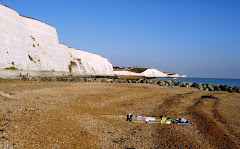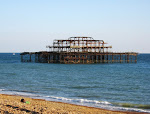
Nowadays, most people think of Kensington Olympia as simply the tube station for the adjacent Olympia Exhibition Centre, and indeed it is very convenient for that. But it has a fascinating and complex history of its own, and was once one of the largest and grandest stations in London. So here's a little historical blog for you, with just a hint of transport geekiness.
The first line in the area was the West London line, opened in May 1844, running from the Euston-Birmingham Line at Kensal Green and terminating just south of the present station, at Kensington Canal Basin. In those days, a half-hourly passenger service was provided, but it was not a success and was discontinued later the same year. The line became busy with goods, however, with coal being delivered to Shepherd's Bush and Kensington.
In 1863, the West London Line was extended to Clapham Junction, and a circuitous service operated by the Great Western Railway from Southall to Victoria station via Battersea. In 1864, the station on the present site was opened, called simply ‘Kensington’, (it was renamed ‘Kensington Addison Road’ in 1868 when High Street Kensington opened). This coincided with the opening of another branch line, from Latimer Road on the Hammersmith & City line. In 1869, yet another branch opened, from Hammersmith Grove Road station (adjacent to to-day’s H&C station) up to Shepherd’s Bush Green and then curving back down again to Kensington Olympia. This enabled Richmond trains to run via Olympia, West Brompton and Battersea to Waterloo. Finally, in 1872, the District Railway built a short line from Earl’s Court.
Thus Kensington Addison Road became a major station, with trains running in literally all directions. In 1886, the opening of the Olympia Exhibition Hall provided yet another source of traffic. The station was rebuilt on a grand scale, with two long through platforms and bays at both ends. Gradually, however, the development of other underground lines ebbed traffic away. The Richmond service and the line to Hammersmith closed in 1916. Although an electric service to Willesden Junction was inaugurated in 1916, this service, together with the branch to Latimer Road closed in 1940, due to bomb damage, and never restarted. In 1947, the station was renamed Kensington Olympia, but by then it had reduced solely an ad-hoc Underground service to Earl’s Court, run in conjunction with exhibitions at Olympia.
By the 1960s, the magnificent buildings had been demolished and the station was a quiet backwater. In 1966, however, it received a new lease of life with the opening of the Motorail terminal, with car-transport services to wide range of destinations in Scotland, Wales and the West Country. These ceased in 1988, and the Motorail terminal closed down. It is now used as a car-park, and the former reception area is the booking hall and ticket office.
But, the story has a relatively happy ending: a renaissance began in 1986 when the District Line recommenced a full service, joined in 1994 by a rejuvenated service on the West London Line, from Willesden Junction to Clapham Junction, and from Watford Junction to Brighton. These have both flourished, and over a million passengers a year now use the station.
There are now effectively four sets of services:
- Willesden Junction to Clapham Junction service every half hour, augmented in frequency and extended to Stratford via the North London line in the peaks.
- from Watford Junction to Clapham Junction, Gatwick Airport and Brighton (operated by Southern; runs hourly, cut back to Clapham Junction in the evening, and on Sundays)
- District Line to High Street Kensington via Earls Court: about every 15 minutes, with extra trains for major exhibitions;
- five Cross-country trains a day, to/from Birmingham, Manchester, Gatwick Airport and Brighton. These are due to be withdrawn in 2009.
Some practicalities:
District line trains have their own bay platform on the west side of the station, next to the ticket office. There are passenger toilets available when the ticket office is open, but they are not suitable for wheelchair users. Other services include cycle storage racks, a first-aid post, public telephones and a small coffee kiosk on platforms 1 and 2.
The station has step-free access throughout, although there is no lift to the footbridge, so passengers wanting platform 3 to Clapham Junction must use the Addison Road entrance. (It’s a good 5 minute walk from the ticket office and the other platforms.)



2 comments:
Shame that the XC services are ending when the timetable changes! Apparently it's not part of Arriva's franchise agreement and isn't financially viable by itself. There goes the central London bypass route!
Yes, it is a pity, as the line is incredibly convenient for those who don't wish to change trains and fight with the underground system, or simply those who don't want to change at Watford and then Clapham Jn as the alternative.
Post a Comment